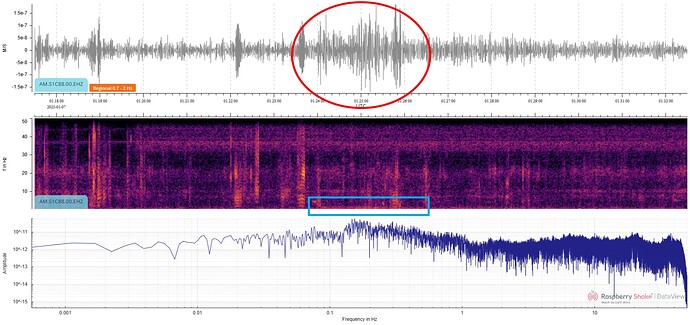I saw the Xizang 7.1 magnitude quake in the news. Now, it’s 7890 miles away from my station. The Shake app didn’t really show anything, but did show the P wave, which gave me a time frame, with the delay to me. I went to my data view and drilled down in the time, but still didn’t see anything. Curiously empty at around 0120 UTM on 01.07.2025. Data View: Raspberry Shake Data Visualization Tool
Was this quake just too far away to register 7000+ miles away, or am I looking in the wrong place? Is there anyone here who might look at my data view and see if it is there somewhere? Very new at this and not sure what to look for. Perhaps it’s buried in the noise, or a nearby squiggle is the actual quake? I am going by the app and when it says the P wave hit.
Thanks!
1 Like
A very interesting question!
The reason why you are not seeing anything from this large event is because, at that distance, you are fully inside the shadow zone, thus not receiving any direct P or S waves from this earthquake. A basic introduction to this concept can be found here: Seismic Shadow Zone: Basic Introduction- Incorporated Research Institutions for Seismology.
To see something, you have to move ahead and see if you managed to record any core waves (waves that, in some way or another, cross or bounce around the Earth’s core). And, in fact, almost hidden, you did!
As you can see, the trace is very difficult to recognize at first glance (even filtered), and all its energy is concentrated at the very low frequencies of the spectrogram. Those are PKIKP core waves that have reached your location after being reflected from the planet’s solid inner core boundary.
You can find an excellent reference for all types of seismic waves here: IASPEI standard phase list.
Thank you, Giuseppe, for this explanation. I had a feeling distance was the issue. I will study these links (noobie that I am). I learned much of this at college but many years ago and things fade.
Would the 3D Shake be any more capable of recording far-off but strong quakes with its additional geophones? Or are they both essentially the same (versus Shake+Boom I now operate)? Or, is my geographic relation to this particular quake the limiting factor?
Chris
2 Likes
Always welcome, Chris.
In this case, it’s your geographical location that makes the difference. Being where you are, all events from that portion of the world (approximately 7000mi to 9800mi from you) will fall inside the shadow zone.
Depending on the time of the day (as it’s quieter during the night) and earthquake magnitude, you could receive something… or not. It’s something that always varies from earthquake to earthquake.
The geophones in both the RS3D and the RS&BOOM are the same model, presenting the same performance. You would get additional details (horizontal channels) with an RS3D when the earthquake epicenter is outside the shadow zone, that’s guaranteed, but results from inside the zone would depend on many variables.
1 Like
Thank you again. I guess I’m trying to justify adding a 3D to my Shake+Boom in light of the special pricing. I understand the 3D and S+B use the same geophone, but three times the data? Very keen on this new hobby, so want to make full use of all the capabilities. C
2 Likes
I understand you, as I had similar thoughts in my mind when deciding if I wanted to move from my RS1D to the RS3D (which, in the end, I bought some months after).
